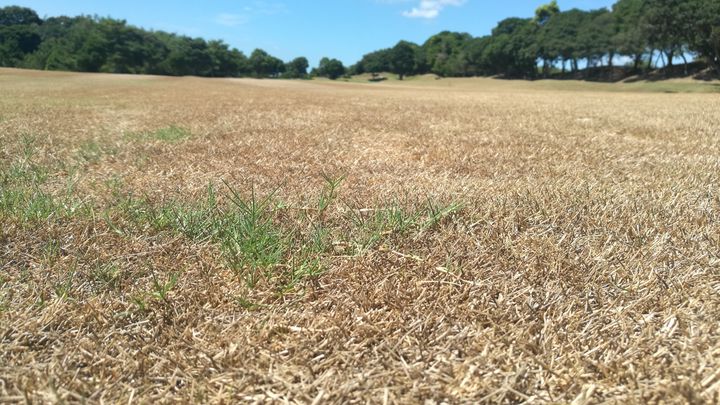Drought, bermudagrass, and zoysiagrass
 Bermudagrass is green and growing in dry soil that has caused dormancy in surrounding zoysiagrass
Bermudagrass is green and growing in dry soil that has caused dormancy in surrounding zoysiagrassThere’s an interesting article by Zhang et al. about warm-season grass and what happened under water scarce conditions during 21 day dry down periods. This article, Drought responses of above-ground and below-ground characteristics in warm-season turfgrass, reports on an experiment in which bermudagrass (Cynodon dactylon), manilagrass (Zoysia matrella), Japanese lawngrass (Zoysia japonica), and St. Augustinegrass (Stenotaphrum secundatum) were grown in a sandy soil. Irrigation was withheld for three weeks in May of 2013. Irrigation was also withheld for three weeks in May of 2014.
Here are some quotes from the paper, with emphasis and interspersed notes mine:
The objectives of this study were to compare the above and below-ground responses during drought of four warm-season turfgrass species, followed by a period of recovery with irrigation resumed.
This is a three week dry-down during which it rained five times in 2013 and four times in 2014 (see Figure 1 in the paper. I estimate rain of about 32 mm in 2013 and about 22 mm in 2014). Even so, both species of zoysiagrass “completely entered dormancy.”
Despite a few rain events … , extensive drought stress developed in most of the species except for common bermudagrass. At the end of dry down, Japanese lawngrass and manilagrass completely entered dormancy with turfgrass quality ratings less than 2 [on a scale from 1 to 9] … But the turfgrass quality of common bermudagrass was 5.6 and had minimal leaf firing.
On root characteristics:
Common bermudagrass also had the highest maximum root depth and lowest surface root fraction … ; while both zoysiagrass species had lower maximum root depth and greater surface root fraction than St. Augustinegrass.
On one aspect of the data analysis:
Principal component analysis was performed on root characteristics, turfgrass quality and leaf firing at the end of drought … in an attempt to reveal clusters of similar root morphological traits that were correlated with canopy traits.
Four warm-season turfgrass species formed distinct clusters, with common bermudagrass in the fourth quadrant … , indicating its lower surface root fraction, less leaf firing, combined with greater turfgrass quality, maximum root depth, root length and root surface area at 30-90 cm depth. Japanese lawngrass and manilagrass, with higher surface root depth, severe leaf firing, lower turfgrass quality, maximum root depth, root length and root surface area at 30-90 cm, were grouped in the second quadrant.
Information from this project should be used to educate end users and water management districts in the selection and management of species in drought prone regions.